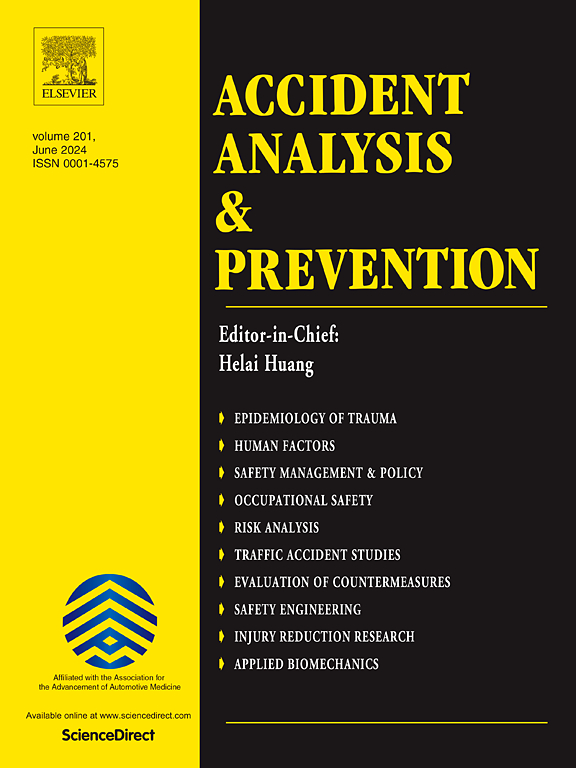Association between automatic emergency braking and pedestrian and cyclist injury severity in Japan
IF 5.7
1区 工程技术
Q1 ERGONOMICS
引用次数: 0
Abstract
This cross-sectional study assessed whether automatic emergency braking (AEB) in colliding passenger cars is associated with reduced injury severity among pedestrians and cyclists in road traffic crashes. We used national police-reported data in Japan from 2016 to 2019 on vehicle versus pedestrian and vehicle versus cyclist injury crashes, focusing on six best-selling car models with optional AEB systems. We analyzed the association between AEB presence and injury severity, dichotomized as fatal/serious versus minor/no injury, using multivariable logistic regression, adjusting for potential confounders. Among 4131 pedestrians and 6659 cyclists involved in crashes, AEB was associated with a 20 % decrease in the odds of fatal or serious injuries among pedestrians (adjusted odds ratio: 0.80, 95 % confidence interval [CI]: 0.64–0.996). No significant association was observed for cyclists (adjusted odds ratio: 0.91, 95 % CI: 0.74–1.14). In conclusion, AEB systems may mitigate injury severity even when collisions cannot be avoided, at least for pedestrians in real-world conditions. Future studies should evaluate the effectiveness of newer AEB systems that detect cyclists and explore variations in effectiveness according to driver characteristics.
日本自动紧急制动与行人和骑自行车者受伤严重程度的关系
这项横断面研究评估了碰撞乘用车的自动紧急制动(AEB)是否与道路交通事故中行人和骑自行车者受伤严重程度的降低有关。我们使用了2016年至2019年日本国家警察报告的车辆与行人、车辆与骑自行车者伤害碰撞的数据,重点关注了六款配备可选AEB系统的最畅销车型。我们使用多变量逻辑回归分析了AEB存在与损伤严重程度之间的关系,将其分为致命/严重与轻微/无损伤,并对潜在的混杂因素进行了调整。在4131名行人和6659名骑行者中,AEB与行人致命或严重伤害的几率降低20%相关(调整后的优势比:0.80,95%可信区间[CI]: 0.64-0.996)。骑车者未观察到显著相关性(校正优势比:0.91,95% CI: 0.74-1.14)。综上所述,即使在无法避免碰撞的情况下,AEB系统也可以减轻伤害的严重程度,至少对于现实条件下的行人来说是这样。未来的研究应该评估新的AEB系统的有效性,该系统可以检测骑自行车的人,并根据驾驶员的特征探索其有效性的变化。
本文章由计算机程序翻译,如有差异,请以英文原文为准。
求助全文
约1分钟内获得全文
求助全文
来源期刊

Accident; analysis and prevention
Multiple-
CiteScore
11.90
自引率
16.90%
发文量
264
审稿时长
48 days
期刊介绍:
Accident Analysis & Prevention provides wide coverage of the general areas relating to accidental injury and damage, including the pre-injury and immediate post-injury phases. Published papers deal with medical, legal, economic, educational, behavioral, theoretical or empirical aspects of transportation accidents, as well as with accidents at other sites. Selected topics within the scope of the Journal may include: studies of human, environmental and vehicular factors influencing the occurrence, type and severity of accidents and injury; the design, implementation and evaluation of countermeasures; biomechanics of impact and human tolerance limits to injury; modelling and statistical analysis of accident data; policy, planning and decision-making in safety.
 求助内容:
求助内容: 应助结果提醒方式:
应助结果提醒方式:


